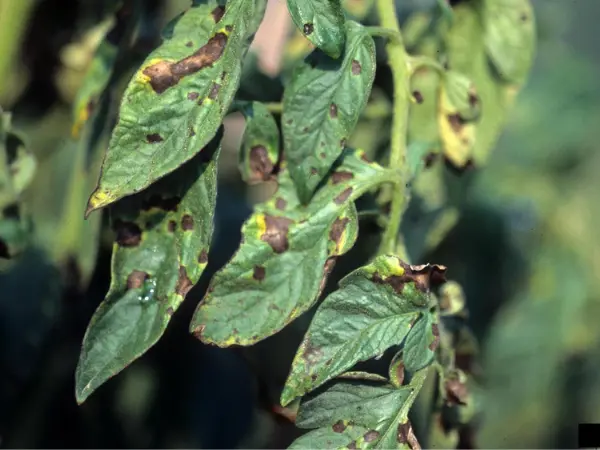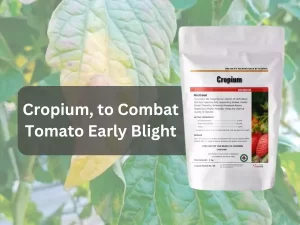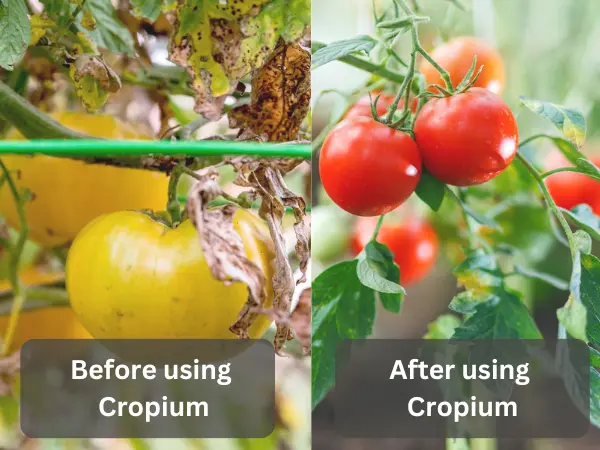Tomato early blight is a very common fungus disease. It’s caused by the fungal pathogen Alternaria saligna, which thrives under such conditions. The first signs of early blight are small brown spots on the bottom side of leaves. They can expand and join as targets’ shape .
If left untreated, the pathogen will propagate to spreading out to young leaves, branches, stems, and fruits leading to heavy damage. Early blight can also infect young plants and even kill them. Mature plants may survive, however, with reduced productivity. Fortunately, there are several good natural remedies for managing and treating the early tomato blight. We’ll take a look at the best natural methods for controlling early blight and offer up some tips on preventing the disease in the first place.

Though often grown in gardens, tomatoes are susceptible to diseases such as Early Blight. The most common fungal leaf spotting (early blight) on tomatoes results in yellowing of the leaf margins, stems or entire leaves, thus reducing the plant’s productivity.
Throughout this article, I’ll be talking about organic strategies for preventing and eradicating Early Blight in your tomato plants. And here’s some helpful tips to grow a thriving tomato crop from seed.
Early Blight on Tomatoes — The DiseaseEarly blight, which is caused by the fungus Alternaria solani, is one of the most common and destructive diseases affecting tomatoes. Alternaria solani, a fungus responsible for early blight in warm and moist environments.
Early symptoms are typically tiny brown spots on old leaves of tomato. These dots may eventually connect, forming targets. It can spread to younger leaves, stems, and fruits, causing significant damage if not handled early on.
Early blight on tomatoes, for instance, is not only difficult to control but also deadly (can kill young seedlings). If older plants can survive at all, their yields will certainly drop off. Crop-specific biological control products are designed to target specific pests and pathogens in ways that are both efficient and environmentally sound. This makes them an excellent alternative to conventional chemical treatments for pests and diseases in farming.
Good cultural practices will decrease the risk of early blight when practiced. Remove dead plant material to prevent the spreading of fungal spores. Don’t spray down leaves with watering cans; instead, get to the root zone (below leaves will cause diseases). Organic mulch not only helps to conserve moisture but also stops the spread of fungal spores that can splash onto the leaves.
Early detection and prompt action are key in the hope of stopping this disease from spreading any further. Fungicide applications using copper-based materials, under organic protocols, provide some management of the disease. Apply the fungicide as per manufacture suggestion over all of the leaves.
Implementation should be consistent when the humidity is high or during rains.
To deal with early wilt and other fungal issues, think biocontrol before chemical. For example, the beneficial bacteria Bacillus subtilis and Trichoderma harzianum suppress fungal pathogens. You can use sprays and soil drenches as prophylactic (preventative) or curative (early treatment) treatments.

Cropium is a biological fungicide that can be used to control early blight and other fungal diseases on tomatoes. It contains the active ingredient Penicillium bilaiae, which is a beneficial fungus that produces a natural antibiotic that can kill the early blight fungus.
To use Cropium, simply mix the recommended amount of product with water and spray it on the affected plants. Be positive to comply with the guidelines at the label carefully.
Benefits of Cropium: Cropium — A biocontrol chemical for controlling the diseases of early blight as well as other fungal diseases in tomatoes. Cropium consists of Bacillus subtilis as its active component — a valuable bacterium, producing its own natural antibiotic to combat powdery mildew.
When working with Cropium, you just need to blend the indicated volume of compound with water, and apply it on the ailing plants. As you can see from the label’s instructions, follow them very carefully.
Other Biological Control Methods: Besides using Cropium for the treatment of early blight, you can use plenty of other biological control methods also. These include:
Trichoderma harzianum: This fungus is a parasite to the powdery mildew fungus. Early blight, a fungal menace, can wreak havoc on your tomato patch. But fear not, brave gardener! This insidious enemy can be outwitted with a blend of preventative and curative strategies, drawing from both biochemical and horticultural expertise.
Prevention is key for tomato early blight:
When prevention fails, early intervention is crucial:
By combining these proactive steps with swift action, you can keep early blight at bay and enjoy a bountiful harvest of delicious, disease-free tomatoes. Remember, knowledge is your weapon, and vigilance is your shield. So, arm yourself with these insights and go forth, defender of the tomato patch!
To use Cropium as a preventative treatment, dilute it according to instructions and add water. Spread the solution consistently over both the foliage and stems of your tomato plants and their surrounding soil. Creating a defensive boundary makes it harder for Early Blight to manifest.
Moreover, Cropium is designed not only for tomato plants but also works well with other vegetables, including eggplant and potatoes. Ornamental plants benefit from the use of Cropium as well. For specific instructions on how to use the product, always refer to the label.
Organic product Cropium can be safely used in gardens and farms. One must adhere to the labeled recommended usage and safety guidelines when dealing with pesticides or fungicides. When applied correctly, Cropium results in no major health concerns for humans.
To avoid outbreaks, especially during warm and humid periods when Early Blight might be widespread, it is recommended to apply Cropium every 7-10 days. To address an Early Blight problem in tomato plants, consult product guidelines on treatment frequency.
Carefully read and follow the instructions for each product when using Cropium in conjunction with other organic fungicides or pesticides. To prevent diminishing effectiveness, it is usually a good idea to avoid combining Cropium with chemical fungicides or pesticides.

To have the healthiest tomato plants possible, early tomato early blight treatment is crucial. Thankfully there are quite a few methods you can use as well; biocontrol measures, crop rotation, organic fungicides, and reducing how often you apply antibiotics.
Novobac products coupled up with the above mentioned ways will be able to enhance your plants ability to respond against tomato early blight in its initial stage. Novobac – specializes in the development of natural protection for tomato early blight. These products use fungi-killer microorganisms such as Bacillus subtilis and Trichoderma harzianum to boost plant health by suppressing the growth of fungal pathogens.
Early tomato blight means quick action is required now! Apply Novobac’s biodegradable fungicides according to instructions of the producer. Removal and disposal of infected plant debris should supplement pruning infected leaves and canes in order to prevent the continuation of tomato early blight development.
Happy gardening!
As a plantation owner, I face quite a few..
The banana weevil, also known as Cosmopolites sordidus, is..
Fusarium wilt in banana is usually known to be..

Leave a Reply